By Wisconsin DNR
With 145 invasive plants regulated under Wisconsin’s Invasive Species Rule NR40, it can be challenging to identify some of these plants while out in the woods.
The task can be further complicated by the presence of native lookalikes – plants that have a similar appearance to harmful invasive species but are actually native plants that benefit wildlife, pollinators and ecosystems in Wisconsin.
To unmask and identify the native imposters and differentiate them from the invasive plants that should be controlled, it’s important to learn a few key characteristics. With a little study and practice, you’ll be able to quickly differentiate between these perplexing pairs.
Here’s how to correctly identify six pairs of commonly confused plants that are in bloom right now.
1. Invasive wild parsnip (Pastinaca sativa) vs. native golden alexander (Zizia aurea)
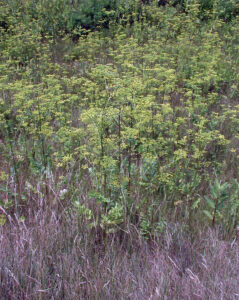
Wild parsnip is often mistaken for native golden alexander. / Photo Credit: Leslie J. Mehrhoff, University of Connecticut, Bugwood.org
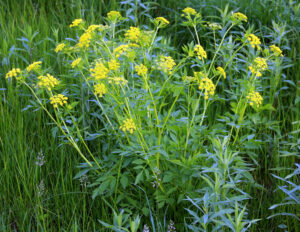
Native golden alexander (pictured) is often mistaken for invasive wild parsnip. / Photo Credit: Steven Katovich, Bugwood.org
Wild parsnip is an invasive plant of special concern due to the possibility of contact phytophotodermatitis – a skin reaction triggered when the sap of broken parsnip plants (in leaves, stems and flowers) contacts skin and is then exposed to sunlight. Reactions can vary from minor rashes to severe burns and scarring, so wild parsnip is a plant to be avoided.
Native golden alexander looks very similar to wild parsnip, so much so that the two are often mistaken for one another. Both plants have similar flowers in umbels (umbrella-shaped flower arrangements).
Golden alexander is significantly smaller than wild parsnip when mature, growing only to three feet in height. It has smaller leaves and smaller, looser, uneven flower clusters. Golden alexander also blooms first, while wild parsnip blooms later in the season.
Leaf shape can be used to tell the two apart. Wild parsnip leaves are deep and forked with coarsely toothed edges; golden alexander leaves are finely toothed with pointed tips.
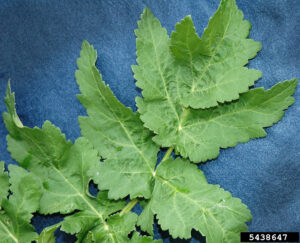
Wild parsnip leaves are coarsely toothed with wrinkled veins. / Photo Credit: Katy Chayka, www.minnesotawildflowers.info, Bugwood.org;
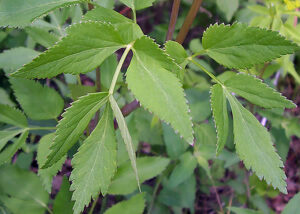
The golden alexander plant has finely toothed leaves with pointed tips. / Photo Credit: Bruce Ackley, The Ohio State University, Bugwood.org
2. Invasive non-native honeysuckles (Lonicera spp.) and native American fly honeysuckle (Lonicera canadensis)
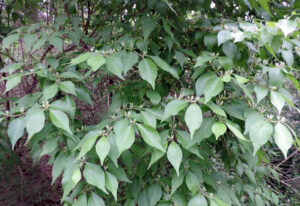
To determine if a honeysuckle is a native or invasive species, break off an older branch and check the pith. / Photo Credit: Richard Gardner, Bugwood.org
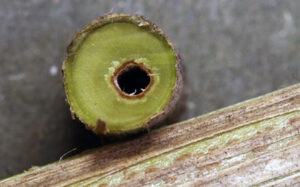
The pith of invasive honeysuckle, seen here, is brown and hollow. / Photo Credit: Chris Evans, University of Illinois, Bugwood.org
There are several types of invasive Eurasian bush honeysuckles in Wisconsin, and it can be easy to think that every honeysuckle you find is invasive and should be controlled. While this would be a simple way to think about honeysuckle, it isn’t the reality. American fly honeysuckle is another similar-looking member of the Lonicera family that is native to Wisconsin.
When in bloom, the flowers of invasive Amur, Bell’s, Morrow’s and Tartarian honeysuckles may help with identification. American fly honeysuckles have pale yellow flowers that occur at the end of each branch and hang down. Without the blooms, you may look for shaggy, grayish-brown bark to help identify an invasive honeysuckle. Identification of the correct species is less important than determining if the bush honeysuckle is, in fact, invasive or if it is a native species.
The easiest way to determine a non-native honeysuckle from one of the native plants is to do a “pith test.” Break off an older branch of the honeysuckle bush to check the pith (the inner tissue of the branches and stems). If the pith appears solid and white, the shrub is a native honeysuckle; if the pith is brown and/or hollow (like the photo below), it is likely one of the invasive bush versions.
3. Invasive Dame’s rocket (Hesperis matronalis) vs. native phlox species (Phlox)
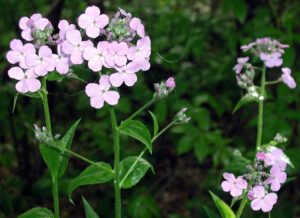
The invasive plant dame’s rocket has four petals per flower. / Photo Credit: Leslie J. Mehrhoff, University of Connecticut, Bugwood.org

Native phlox species have five petals per flower. / Photo Credit: Chris Evans, University of Illinois, Bugwood.org
Dame’s rocket and native phlox species present very similar appearances. Both have similarly colored flowers that grow in clusters and are in bloom around similar times.
Dame’s rocket invades both wooded and open areas and is often included in wildflower seed mixes. It is often mistaken as a native wildflower, but as an invasive, it contributes to habitat loss for native species.
A look at the leaves of these plants provides good identifying information. Phlox has leaves that grow mostly opposite (in pairs, across from each other) and are untoothed (smooth edges). Dame’s rocket has alternating leaves with small teeth on the margins.
An even easier trick to tell the two apart is by simply counting petals. The flowers of dame’s rocket have four petals; those in the phlox family have five. An easy trick to remember this is that phlox has five letters in its name and its flowers have five petals as well.
If you encounter one of the named species, use the key identifiers to determine whether the plant is native or invasive. While it may seem easier to simply pull the plant either way, if the plant in question is native, it is likely an important part of its ecosystem and is likely serving as food or habitat for pollinators or wildlife.
4. Invasive giant hogweed (Heracleum mantegazzianum) vs. native cow parsnip (Heracleum maximum)

Giant hogweed (left) and native cow parsnip (right) have similar umbel-shaped flowers. Hogweed is taller (up to 15 feet) and has wider stems (2-4 inches in diameter); cow parsnip grows no taller than 8 feet with stems 1-2 inches in diameter. / Photo Credits: Left, USDA APHIS PPQ – Oxford, North Carolina, Bugwood.org; Right, Wisconsin DNR
Like wild parsnip, giant hogweed is another invasive plant of high public interest due to the potential for contact phytophotodermatitis (a skin rash following contact with the plant and with ultraviolet light). While populations of giant hogweed are infrequent in Wisconsin, the plant is often confused with the abundant and pollinator-friendly native cow parsnip.
Giant hogweed lives up to its name, growing 8 to 15 feet high; cow parsnip tops out at 8 feet or shorter. The flowers on both plants are similarly shaped in umbels, but giant hogweed clusters are much larger (1 to 3 feet across). Hogweed stems are also much larger, growing 2 to 4 inches in diameter.
Check out the DNR’s giant hogweed vs. cow parsnip publication to review the differences between the species.
5. Invasive multiflora rose (Rosa multiflora) vs. native prairie rose (Rosa arkansana)

Invasive multiflora rose (left) has many flowers blooming in clusters. Native prairie rose (right) has larger blooms that are often pink. / Photo Credits: Left, Denise Ellsworth, The Ohio State University, Bugwood.org; Right, Katy Chayka, Minnesota Wildflowers, www.minnesotawildflowers.info

Invasive multiflora rose has distinct backwards-curving thorns and fringed stipules (where the leaf stem meets the stalk) that make it recognizable. / Image Credit: Chris Evans, University of Illinois, Bugwood.org.
Multiflora rose is an invasive shrub that can be easily found in woodlands, especially in the southern portion of the state. As its name suggests, multiflora (many-flowered) shrubs have multiple roses growing in distinct clusters. Multiflora roses are generally white or slightly pink. While the color of native blooms can vary, they are often pink and larger in size.
Other characteristics that differentiate the invasive from the native species require a closer look at the leaf stalks and stems. The invasive multiflora rose has backward-curving barbs; the native roses have slender, straight thorns.
You can also identify an invasive rose by finding the stipules (hair-like protrusions at the base of each leaf stem, where they meet the stalk). Stipules are distinctly fringed on the invasive multiflora rose and are a simple, smooth pair on the native.
6. Invasive round leaf bittersweet (Celastrus orbiculatus) vs. native American bittersweet (Celastrus scandens)
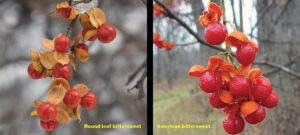
Invasive round leaf bittersweet (left) and the native species American bittersweet (right) have similar appearances. Berries grow all along the stems of the invasive, while larger berries grow only at the tips of stems on the native species. / Photo Credits: Minnesota Department of Agriculture.
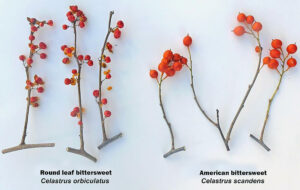
Invasive round leaf bittersweet (left) and the native species American bittersweet (right) have similar appearances. Berries grow all along the stems of the invasive, while larger berries grow only at the tips of stems on the native species. / Photo Credits: Minnesota Department of Agriculture.
Invasive round leaf bittersweet, also known as Oriental bittersweet, is a popular decoration in the fall and winter months due to its showy berries. The red-orange fruits grow all along the branches of this invasive, strangling vine. When used in décor, new infestations may be spread from still-viable plant seeds or debris during transport or when improperly discarded.
Wisconsin’s Invasive Species Rule NR40 prohibits the sale or transfer (including as gifts) of 145 restricted plant species, including round leaf bittersweet. However, fans of the plant can still get the look of bittersweet without the nasty invasions by opting for American bittersweet instead.
To identify the native vs. the invasive bittersweet, look closely at the fruit. Round leaf bittersweet has red-orange berries all along the stem; American bittersweet has berries just at the end of each stem. The fruits of American bittersweet are also larger than those of the invasive bittersweet.
There are plenty more invasive plants to learn to identify. Once you have mastered these pairs, check out the DNR’s Regulated Species webpage for more identification information and common lookalikes.
